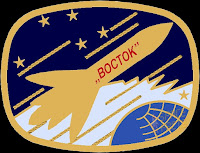Soviet Space Program Vostok Patch.
Dec. 1, 2020
Exactly 60 years ago, on December 1, 1960, the Vostok launch vehicle was launched from the Baikonur cosmodrome with the third satellite 1K, the next prototype of the future Vostok manned spacecraft. The spacecraft with the dogs Mushka and Pchelka fully completed the flight test program, but was destroyed on return to Earth as a result of an emergency.
Pchyolka ("Little Bee") and Mushka ("Little Fly") in Vostok spacecraft
The creation of a domestic manned spacecraft began at OKB-1 (today the SP Korolev Rocket and Space Corporation Energia, part of the State Corporation Roscosmos) by Government decree of May 22, 1959. A year later, the OKB-1 design group under the leadership of Chief Designer Sergei Pavlovich Korolev completed the development of the main systems and assemblies of the new apparatus, and Experimental Plant No. 88 (now ZEM RSC Energia) manufactured the first product samples in cooperation with other rocket enterprises. -space industry. Experimental automatic ships 1K with biological objects were intended for testing onboard equipment and radio-technical means of control, checking the operability of the life support system and studying the effect of space factors on living organisms.
Vostok spacecraft
The third satellite continued the research program of the previous flight of the Belka and Strelka dogs, which returned safely to Earth. This time in the ejection container were experimental dogs Mushka and Pchelka - two females of light color, two and four years old, who had undergone a set of pre-flight training at the Moscow Institute of Biomedical Problems. In addition, cages with guinea pigs and mice, flasks with fruit flies, ampoules with plant seeds, biological tissues and DNA samples, bacterial cultures, viruses and enzymes were placed in the sealed cabin of the ship. The registration of the physiological indicators of the dogs in flight was provided by sensors, the information from which was transmitted to ground measuring points along with the telemetry data of the ship. The observation of the state of health and motor activity of animals under conditions of prolonged weightlessness was carried out using television equipment and motion sensors.
Soviet dogs test-bed suits
On December 2, 1960, at the eighteenth orbit, the ship entered the descent mode after the completion of the daily program of experiments. As a result of a failure of the brake motor control system, it ended up in an off-design orbit and was automatically blown up in order to avoid an uncontrolled landing outside the territory of the USSR. Despite the tragic death of the four-legged crew, the data obtained during the flight of the third spacecraft 1K again confirmed the correctness of the selected technical solutions when preparing manned space expeditions. The program of experimental testing of automatic satellite ships made it possible to carry out on April 12, 1961, the first ever manned space flight on board the manned Vostok spacecraft.
ROSCOSMOS Press Release: https://www.roscosmos.ru/29629/
Images, Text, Credits: ROSCOSMOS/Orbiter.ch Aerospace/Roland Berga.
Greetings, Orbiter.ch




